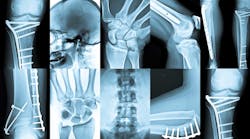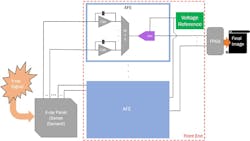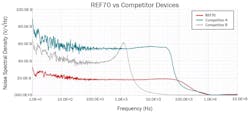Maximize X-ray Imaging Performance with Low-Noise Precision Voltage References
What you’ll learn:
- Noise is the enemy of X-ray image resolution.
- Digital-subtraction radiology compensates poorly for front-end circuit noise.
- A sufficiently low-noise voltage reference increases the SNR in the front end’s ADC.
X-ray imaging is one of the most widespread medical imaging technologies, and as such, many efforts are underway to improve X-ray imaging performance—specifically, increasing the resolution of the image produced.
One of the most effective ways to improve the image resolution of an X-ray is to reduce the noise present in the front end. Careful design of the data-acquisition portions of the front end can help achieve this goal. Using a low-noise series voltage reference in the data-acquisition circuit is one design choice that can lead to lower noise and thus a higher-resolution image.
[In this article, to differentiate between a custom chip-on-film device and the front end of the X-ray system, any use of “analog front end (AFE)” will refer to a chip-on-film device, and any mention of “front end” will refer to the section of the X-ray system that contains a chip-on-film device, a voltage reference, and other devices.]
General Overview of X-ray Imaging Operation
In an X-ray system, an AFE receives the generated signal from the X-ray panel. An AFE is a specially designed integrated circuit where data acquisition in the front end takes place. X-ray systems include multiple AFEs that are specifically designed to be used in X-ray systems, all of which use a common voltage reference. Figure 1 shows a simplified block diagram of an X-ray device front end.
The AFE converts a charge coming from the X-ray panel into a voltage by using a charge-summing amplifier (CSA). This voltage is then fed into a multiplexer that provides an analog signal to an analog-to-digital converter (ADC). The ADCs present in the AFE use an external precision voltage reference to provide accurate data conversion. A field-programmable gate array (FPGA) or other processor then processes the output.
Once the front end has a digital signal, digital subtraction radiography helps improve the image quality. Digital subtraction radiography compares a scan of the patient and a scan without the patient to remove image flaws. The two images are taken within a short time frame.
In this short period of time, because the X-ray system is in a temperature-controlled environment, the change in temperature is minimal. However, the process of digital subtraction radiography compensates for image discrepancies caused by any small temperature change in the front end.
Implementing a Low-Noise Circuit
The noise of a circuit may change drastically in a very short amount of time. Therefore, digital subtraction radiography isn’t effective in removing image flaws caused by noise in the circuit. Noise is a random event, and not something that can be controlled. Any noise present in the front end—including in the precision voltage reference and the AFE—will propagate through all channels and decrease the final image resolution, leading to a low-quality image.
In high-precision applications, an internal voltage reference in an ADC, digital-to-analog converter (DAC), or AFE can’t meet the application’s accuracy, noise, temperature drift, or long-term drift specifications. Often, an internal voltage reference isn’t even available, or doesn’t meet the noise specifications necessary to produce a high-quality image.
An external precision voltage reference with ultra-low noise can help improve image resolution and reduce the number of X-rays taken, thus reducing patient and medical professional exposure as well as healthcare costs. Table 1 defines voltage-reference parameters to consider.
Depending on the number of bits or effective number of bits (ENOB) of a DAC or ADC, the parameters in Table 1 can directly affect the gain error and signal-to-noise ratio (SNR) of the circuit. In an X-ray system, a higher gain error translates to decreased image quality. Also, the flicker noise of a voltage reference affects the SNR of the ADC.
Equations 1 and 2 show the noise and SNR in an ADC:
From Equation 1, you can see that as the noise of the voltage reference decreases, the total ADC noise drops as well. Looking at Equation 2, you can see that decreasing the voltage reference noise leads to an increase in the SNR of the ADC. A higher SNR would lead to a higher ENOB, which is necessary for higher system resolution. Therefore, it’s important that the voltage reference noise be much less than the noise of the ADC.
In addition, using a filter to decrease the noise on the output of the voltage reference would slow down the system. For this reason, having low noise would be valuable in applications such as X-ray imaging because it would help avoid any need for filtering.
In many cases, opting for an external voltage reference such as the REF70 from Texas Instruments can assist in improving the SNR of the ADC. A precision voltage reference with low noise would be an essential consideration. Table 2 lists the parameters of the REF70 series voltage reference.
Lowering the noise present in the analog front end by choosing a low-noise precision voltage reference like the REF70 will also increase the SNR in the ADC, which would enable improved image resolution in X-ray systems. Figure 2 compares the noise of the REF70 (from 1 Hz to 10 MHz) with competing devices.
Conclusion
Boosting the quality of X-ray images can only improve the medical care that people receive. Given the expansive use of this type of medical imaging, a plethora of opportunities for technological advances are possible in this space. Such advances will continue to help improve healthcare around the world.
When designing an X-ray system, the goal is to produce the best image possible. There are many ways to achieve that, but among the most important is choosing the best voltage reference for the design of the X-ray system’s front end. Choosing a device such as the REF70 can help improve the resolution of the image and the overall image quality.






